[Post originally published on substack on January 31, 2023.]
Soaring through the air in graceful motions. Fighting for every tenth of a point. Taking risks vs. playing it safe. Determination, dedication, friendships, and rivalries—that’s what Moonland is about. For boys and girls alike, gymnastics is at the center of their lives. While the boys fly through the air in daring acrobatics, the girls cheer them on. Romance, date, and shopping trip shorten the waiting time in between tournaments. Each athlete grapples with his own internal struggles, and each finds his own meaning in doing artistic gymnastics. However, only one is trying to reach the moon.
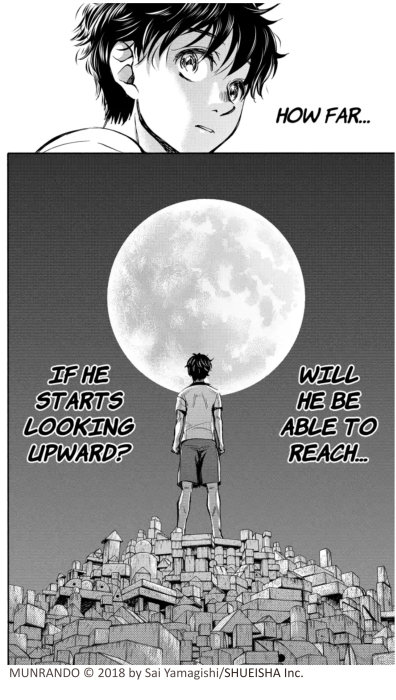
Opposites Attract
The story centers on the two high schoolers, Amahara Mitsuki and Dogase Sakura. They first met as opponents during their last year of middle school at a regional gymnastics competition. Sakura, a short-tempered gymnastics prodigy, could already boast a record of achievements. His primary duty as a member of a large powerhouse club was to get results. Mitsuki, on the other hand, has never set foot inside a tournament hall. Yet, being passionate about this sport, he dedicated himself to learning about its intricacies at a small, no-name club. With such a difference in athletic upbringing, it was clear that they would collide at the first opportunity that presented itself. Sound familiar? Doesn’t the introductory story remind you of the beginning of a well-known volleyball manga?

Anyway, at the tournament, Sakura was enraged that Mitsuki didn’t use his amazing skills to aim for a higher score. The young but seasoned athlete was unaware that the concept of competing was beyond Mitsuki’s grasp. In contrast, Mitsuki couldn’t understand his rival’s sole focus on scores but was still awestruck by his outstanding skills. Watching Sakura’s performance, Mitsuki realized his own shortcomings and wanted to learn more about his opponent’s abilities.
Just as in Haikyuu!! the former adversaries end up being teammates at the same high school (Toda High School), although not by a twist of fate. Mitsuki desperately wanted to be Sakura’s teammate and took matters into his own hands, lest fate betray him. Thus, he tracked down Sakura’s address and future high school to follow him there, and anytime he was at a loss, he looked to his former rival for help. Sakura grudgingly accepted Mitsuki’s presence and eventually supported him whenever he was in need. Although there are plenty of side characters, the story centers on these two young athletes and how they learn from one another to reach “greater heights.”
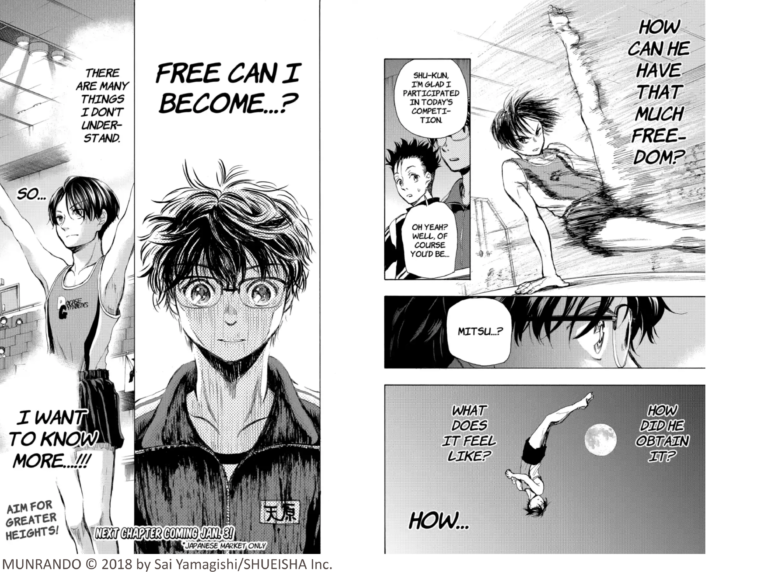
Mitsuki, The Thinker
Mitsuki only went to Toda High to be close to Sakura, but once there, he became rather self-absorbed with his own bodily movements. This obsession is rooted in a defining moment in his childhood. Since this crucial event affects the rest of the story, let’s take a quick trip into Mitsuki’s past.
At the tender age of 8–9 years, young Mitsuki was regularly peeking through the window at the neighboring gymnastics club to observe the ongoing training. His peer, Shibata Shuichirō, invited him to come practice with them, but Mitsuki was plagued by self-doubts. He thought that his inability to move his body through water would negatively affect his ability to move his body on gymnastic apparatuses. (Please feel free to figure out the connection for yourself; I couldn’t find one.) Luckily, Shu was very supportive of his timid and insecure friend and knew just the right thing to say. He encouraged Mitsuki with words that would guide him for the rest of the story: “You’re the only one who can move your own body, right?!” Stunned by this revelation, Mitsuki decided to stop window shopping and, for the next six years, dedicated himself to getting his limbs “completely and 100%” under control.

Until his last year in middle school, Mitsuki led a sheltered gymnastics life, focusing solely on himself. But life in the comfort zone was over the moment the elderly club supervisor coerced him into participating in a regional tournament, where he then encountered Sakura. From this point on, Mitsuki’s self-focus was continuously disrupted by the appearance of amazing rivals who challenged his skills and worldview alike. While trying to claim dictatorship over his body, his mind was heavy with profound musings about the meaning and value of his gymnastics.
As readers, we just have to bear with him. All we can do is take a deep breath as Mitsuki’s conflicted mind tackles the same problem yet again, and hope that this time he will finally find an answer to the questions plaguing him. At some point, even the mangaka, Yamagishi Sai, had no choice but to address this issue openly.
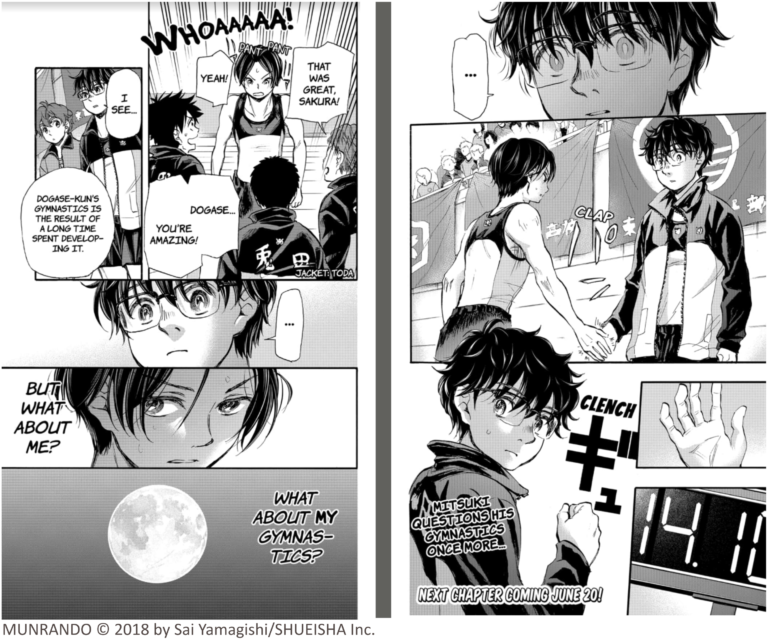
Sakura, The Challenger
Contrary to Mitsuki, Dogase Sakura is a straightforward and down-to-earth character. Born into a gymnastics family, he began training at the Dogase gymnastics club at a young age alongside his older brother, Akira. The boys were instructed by their strict ‘father-coach’, for whom high scores and victories mattered above all else. Under his stern tutelage, the brothers developed into top gymnasts, but regarding professional attention and support, Akira was clearly the favored sibling. Their father didn’t have any understanding for Sakura’s childlike behavior and consequently thought that his youngest son wouldn’t amount to much. The crucial moment in Sakura’s life, though, was during a competition the two brothers took part in. A single misjudgment during a performance cost Sakura his older brother’s support. This fueled his determination to prove his worth by scoring as high as possible and besting his brother in a competition.
But scoring (by the gymnastics rule book Code of Points) is tricky business. The manga informs us that there are over 800 skills across all six events. These are divided into groups according to difficulty and are judged by how flawlessly they are performed. There are other criteria (like connection value), but I’d advise you to read the manga if you are really interested in learning about the scoring system. There is one particular score, though, that Mitsuki has his eye on, and that is the perfect 10.

The Perfect 10
Prior to 2006, even a layman could understand the 0–10 scale of the scoring system, with the perfect 10 being the best score. Looking into this celebrated score, you come across Albert Séguin, who got the first ever perfect 10 at the 1924 Olympic Games in Paris on the side horse vault. (A pommel horse without handles used for vaulting; an event exclusive to the 1924 Olympics.) The first women to score a perfect 10 were Nadia Comăneci and Nellie Kim at the 1976 Olympics in Montreal.

A change in skills and routines also brought about a change in the scoring system. The ‘new’ system is quite confusing, and Yamagishi-sensei, does a great job chopping this extensive part of gymnastics into digestible bits and pieces. As Akari, a female gymnast at Toda, teaches the newbie Omi about the vast world of scoring, I allowed myself to be taught too and can therefore pass this knowledge on to you. From 2006 on, skills are judged according to how difficult they are with the D-score (for Difficulty), and on how well the athletes perform them with the E-score (for Execution). By the way, there is no B-score! (Please remember this; it’s an important point for later on.) The single perfect 10 was lost due to this change, robbing athletes of the chance to attain a ‘perfect’ score. Maybe Yamagishi-sensei wanted to remind the knowledgeable readers about ‘the good old times’, when he had Mitsuki aim for a perfect 10. Theoretically, for the E-score, a perfect 10.0 is still possible, provided an athlete executes all skills in a routine without deductions. In practice, however, this is rather impossible, or so we are told in the manga.
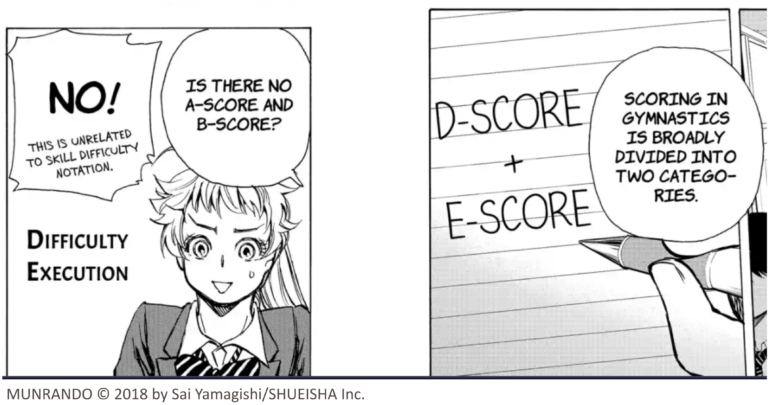
While Mitsuki still dreams of gaining absolute control over his body to score a perfect 10, the girls have already achieved this. With excellent control over their bodily appearances, they attained the perfect 10.0 on the ‘B-score’ (Beauty score). Visuals are provided accordingly, so that the readers can see for themselves that the awarded score is justified. Yamagishi-sensei gives extensive information on how to train for the diverse skills to lose as few points as possible and thereby attain a high score. However, he doesn’t let us in on the specifics of how to obtain a perfect B-score. The guys are also flashing their abs, ready to be judged, but regarding their B-score we are, unfortunately, left in the dark.
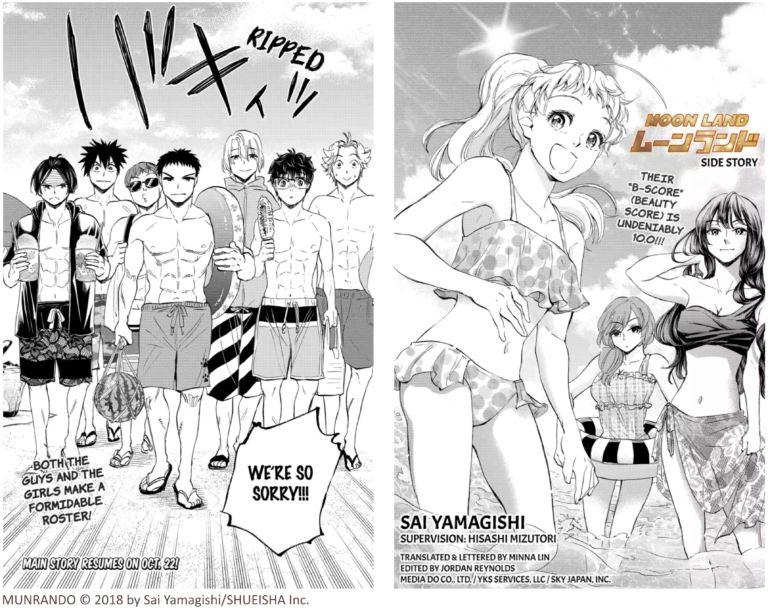
Girls, Girls, Girls, …
Undefined relationships, unrequited affection, and unconditional support define the love life of the (female) teenagers in this sporting environment.
One of the girls is Akari. She is a gymnast on Toda High’s girls’ team and Sakura’s childhood friend. Now, in high school, they still spend time together and seem to gravitate toward each other. Their relationship status is questioned by the other characters, but never answered by the mangaka. So we will, unfortunately, never know. Sakura gets unreasonably jealous, though, when she talks to other guys, particularly Mitsuki. During a lunch break, the three of them sit together, and Akari’s teasing took a turn for the worse, prompting Sakura to present his childhood friend (?) with the harsh reality that hers are the bruised and dirty legs of a gymnast. Mitsuki rushes to her defense, stating matter-of-factly that “Akari’s legs are beautiful.” Akari, praised in such high tones for her ‘gymnastics’, vows to cheer for Mitsuki instead of Sakura in the upcoming practice meet. However, mid-competition, she suddenly abandons Mitsuki and cheers for her rude childhood friend after all. There is no need to feel sorry for Mitsuki, though, because he has no grasp whatsoever on the concept of romance, anyway.
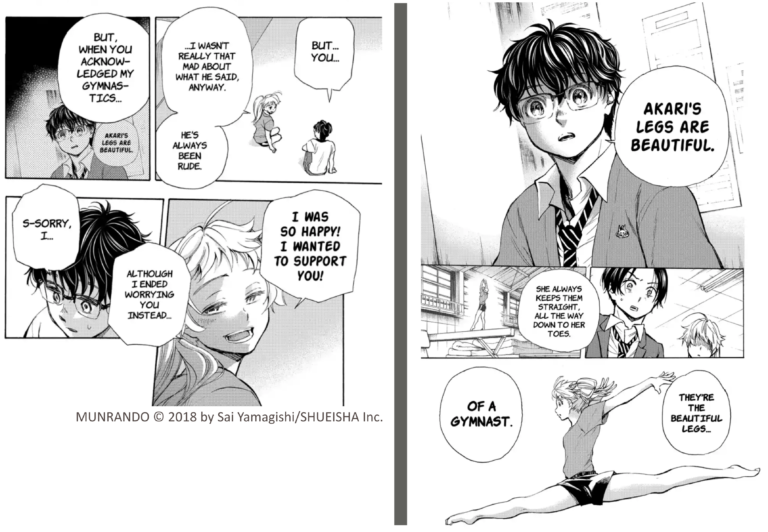
The Model
Mitsuki acts as the knight in shining armor for yet another girl, namely his classmate, the dark-haired beauty Kanako. She, too, has beautiful legs (she is a model), but Mitsuki seems unaware of her attractiveness since she is not a gymnast. Anyway, Kanako is presented as a beautiful but stuck-up girl—a princess—that uses her looks to get guys to do her bidding.
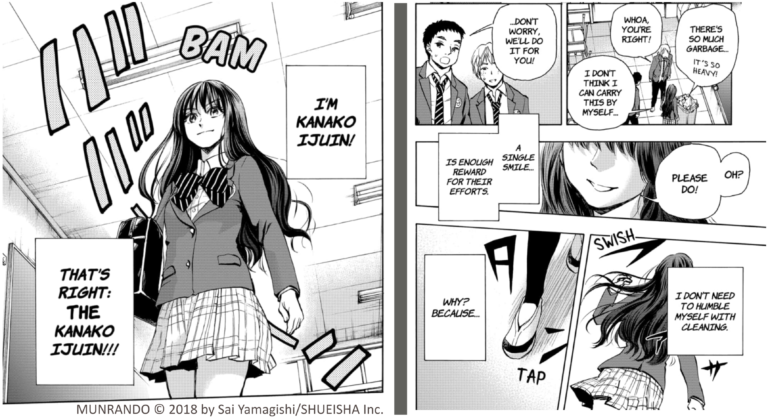
The model wallows in self-pity because she is clueless as to why people say that she has a nasty personality. This all changes after she sees Mitsuki perform during training. Seeing him fly through the air not only makes her question her arrogant attitude but also convinces her of her own worthlessness. Drained of strength due to this realization, Kanako stumbles and falls to the floor in the school hallway. Mitsuki comes to the rescue, helps her to her feet, and sends her off with the comment: “I’ve always thought you have a captivating way of walking.” With these words, he not only restores her self-worth but also makes her fall in love with him, because… well, why wouldn’t you fall in love with a guy that tells you that you look good?

Mitsuki is not aware of Kanako’s romantic feelings toward him because, as is clear by now, he is absolutely clueless about anything that does not involve gymnastics. But Kanako doesn’t mind. As a truly devoted woman, she loves every aspect of her man, even if he is not (romantically) interested in her. There is a lesson to be learned here. Help a girl to her feet, and she will fall for you, regardless of how much you ignore her afterwards… .
The Personal Assistant
Endo Sara is the third girl devoted to one of the male characters, namely Aso Kento, also known as the pommel horse prince for his captivating performances on the pommel horse. Every time he whirls his legs around and around atop the wooden steed, rose blossoms disperse in all directions, and women beholding this sight blush and swoon. No wonder Sara is head over heels in love with this gorgeous heartthrob. At Aso’s bidding, she helps Mitsuki with his skill development because she is actually quite knowledgeable about gymnastics. In the end, she supports all the club members’ performances out of her own free will. But what she really craves is the praise of the person who commands her.

The King And His Stuffed Animal
Visiting his gymnastics advisor, Yamagishi-sensei caught a glimpse of King Kōhei, an encounter that caused him to break out in tears. Uchimura Kōhei is regarded as a living legend and one of the best male gymnasts of all time. You don’t believe me? Just type in his name in your favorite search engine and check for yourself. Reading a bit about him, I could see bits and pieces of the King being reflected here and there in the story. Yet nothing reminded me more of Uchimura than Mamiya Apollo. I am not talking about their appearance, which isn’t similar at all, but about their use of a specific accessory to help them study and learn new skills.
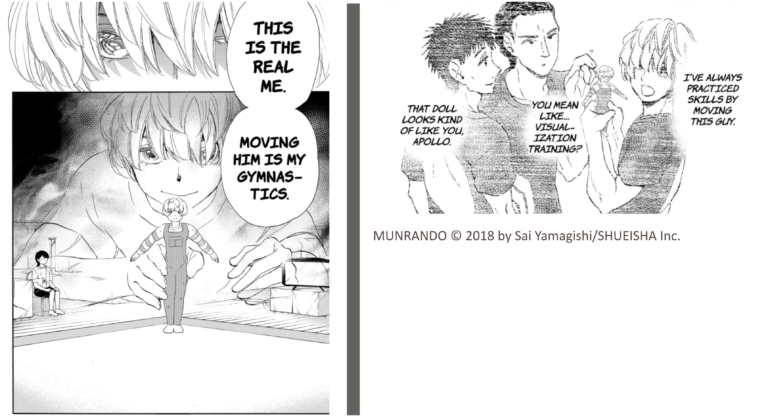
Apollo is part of Akira’s (Sakura’s brother) team and is its second-best athlete. What makes him so successful is visualization training, meaning that he performs routines in his mind and can execute them accordingly. However, Apollo uses more than just imagination to perfect his skills. He also possesses a small-scale lookalike or doppelgänger doll. Twisting and bending his miniature twin enables him to visualize skills and routines and transfer them to the floor, leading to flawless performances. Imagine my surprise when I read that Uchimura did the same thing when he was a child! Although, instead of a ‘mini-me’ he used a stuffed Pink Panther. Truth be told, seeing a small child play with a stuffed animal is a little less disconcerting than seeing a teenage boy play with his miniature self. But let’s not question the artist’s choice. Using a stuffed animal would have been too obvious a reference.
Learning Stuff
Moonland is a so-called explainer manga, a term I first heard on the Mangasplaining podcast—credit where credit’s due. This means, as the word suggests, that it explains stuff. Yamagishi-sensei went through enormous lengths to introduce us to all things gymnastics. Even though the textbook-style explanations of skills and scoring can be a little distracting, they’re nonetheless very interesting. He takes the reader on a journey from basic information about the six events to an overview of the numerous national and international competitions. While the boys are performing their gravity-defying routines, he gives detailed descriptions of skill execution, scoring, and deductions. So, after reading the manga, you really know stuff and are definitely smarter than before!
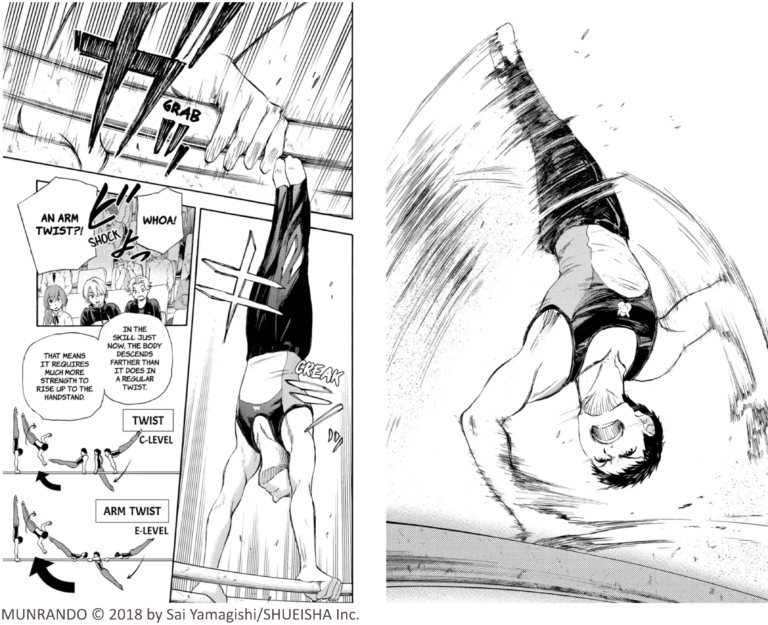
“Gymnastics Is Fun“
The manga is a testimonial to Yamagishi-sensei’s passion for this sport. But he was not alone in his quest to distribute vast knowledge about this Olympic discipline. With the expert help of Mizutori Hisashi, the 2004 Athens Olympics gold medalist (in the team competition), he put to paper a story that is packed with technical details and brimming with gymnastics fandom. Neither injuries nor setbacks could dampen the young men’s spirits. Regardless of mental or technical challenges, the roughly one-minute routines allow plenty of time for elaborate and clarifying thought processes, enabling the athletes to dismount with a light heart and renewed spirit. When not burdened with mundane problems, the boys breezed through the six events with relaxed, smiling faces and dreamy eyes, unperturbed by the gravitational pull. The pages omit positive vibes galore and are illustrated in such a way that the performances are a delight to watch (and read). Clearly, the artist took full advantage of the multimodal medium to convey the central message to us readers: “Gymnastics is fun.”
Moonland is not the first manga to promote gymnastics. There is also The Showman (2018–2020) or, before that, Ganba! Fly High (1994–2000), both of which had gymnasts as athletic advisors.
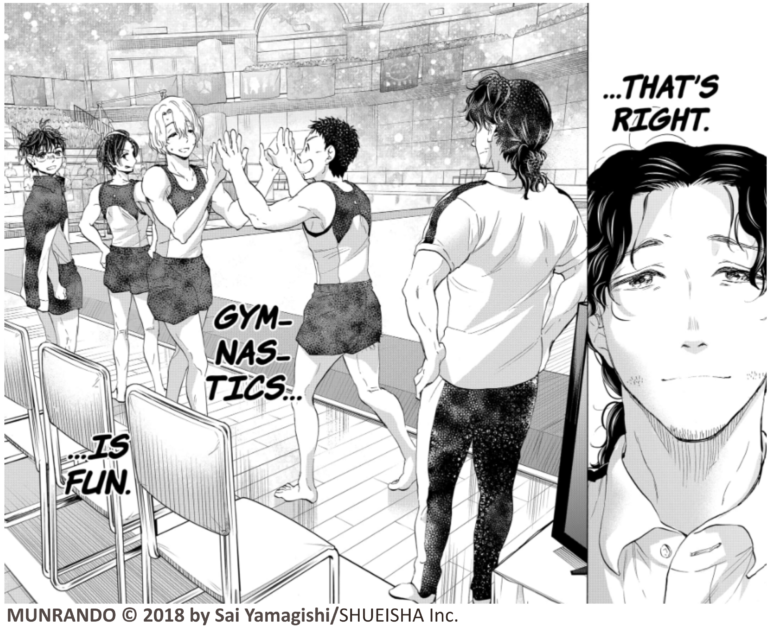
“Life-Changing Gymnastics”
I’m always interested in learning about sports of all kinds, particularly those new to me, so this manga was the perfect fit. The story is somewhat repetitive, particularly since the protagonist, Mitsuki, despite his continuous musings, doesn’t seem to get anywhere. But all is forgiven and forgotten as soon as he takes off his glasses and starts his routine.
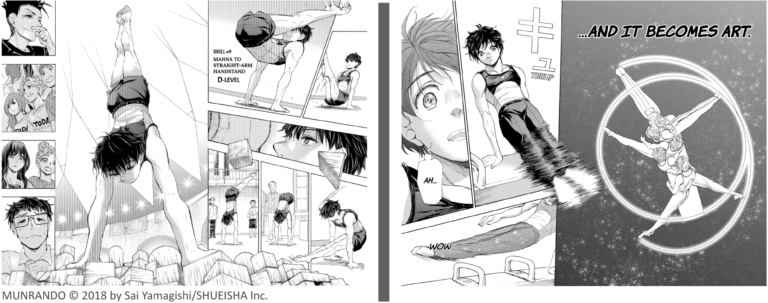
The characters spend most of their ‘screen time’ at competitions, so the readers can enjoy many performances by an array of athletes. It’s advisable not to take the portrayal of certain characters too much to heart. Also, some of the humor might not work for everyone. Assuming you can look past some of the disputable depictions, the manga is an informative and enjoyable read, allowing you to learn about gymnastics in an entertaining way. Once you have read the manga, you might chime in with Mitsuki when he proclaims: “I learned about a lot of amazing gymnastics that I’d never seen before.” If the manga makes you a little curious about this sport, it will have worked its magic. At any rate, its fairy tale ending will conjure a blissful smile upon your face.

Links:
- Original post published on sportsbaka.substack.com
- Moonland is availabe on Manga Plus by Shueisha
Subscribe to never miss a deep dive into the exciting world of sports anime, manga, and manhwa!

